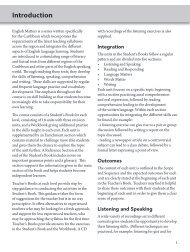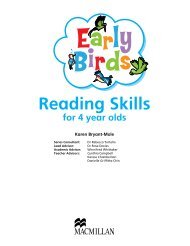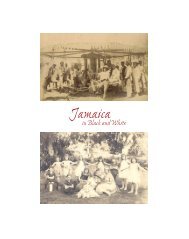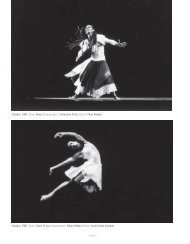Curry, Callaloo & Calypso - Macmillan Caribbean
Curry, Callaloo & Calypso - Macmillan Caribbean
Curry, Callaloo & Calypso - Macmillan Caribbean
Create successful ePaper yourself
Turn your PDF publications into a flip-book with our unique Google optimized e-Paper software.
It would be remiss of me not to speak briefly about the cooking methods that were used in<br />
the early days. The slaves would cook for the plantation owners, much of the cooking taking<br />
place in a building away from the great house. In these buildings the slaves usually cooked on an<br />
open fire contained by large stones. The fire was made in the centre and the pots placed upon<br />
the frame of the stones. If baking was done on this fire the pot was placed over the fire, and the<br />
bread dough placed in the pot. The pot was then covered with a sheet of metal and some heat<br />
was placed on top of this metal sheet so as to give heat at both ends. This method was used to<br />
make what we know as ‘pot bake’. Meats were spit-roasted on an open spit. Other baked items<br />
were cooked in a dirt oven, and many areas had a communal oven where anyone could go to<br />
bake their breads and cakes.<br />
By 1797 the English had conquered the islands, also bringing their own slaves, and a<br />
distinctively different type of cooking began to surface. English expertise was shown in the<br />
making of jams and jellies, and beverages like mauby, sorrel and ginger beer.<br />
In 1834 the slaves were emancipated, and from then they refused to work on the plantations.<br />
The skilled cooks amongst them set up shop on street corners, selling dishes they had learned<br />
to cook, such as souse and black pudding, and hence the parlour or shop-front refreshment<br />
stand was born. The land-owners then began to import workers from Barbados, who brought<br />
their own form of recipes such as float and accras and heavy coconut sweet bread. These were<br />
sold under rum shops and in some instances on the street corner. Workers also began to arrive<br />
from China, Portugal and Madeira, all leaving their mark on our culinary map. The largest group<br />
amongst these was the Chinese, whose cooking was changed considerably to suit the palates<br />
of the locals. Their cuisine is very popular as is evident by the number of Trinidad-Chinese<br />
restaurants that exist today.<br />
East Indian immigrants began to arrive between 1845 and 1917, and were registered under<br />
the indenture-ship system to Trinidad. They<br />
brought with them spices like coriander, also<br />
called dhannia, cumin seed (geera), turmeric<br />
or saffron powder, fenugreek, dried legumes<br />
such as channa (chickpeas), rice, and two<br />
sorts of animal: the water buffalo for hard<br />
labour and a type of humped cattle that<br />
provided milk for their beloved yogurt and<br />
butter which was made into ghee. The spices<br />
were ground by hand on what was called<br />
a sill and made into curries, which have<br />
evolved through the years to the distinctively<br />
delicious curry that has become indigenous<br />
to our country.<br />
The East Indians brought not only<br />
ingredients but their own specific methods of<br />
cooking. When they first arrived they began<br />
to cook on a chulla, or mud stove, made with<br />
a combination of river mud, leaves and sticks,<br />
and cow dung. Water was used to smooth<br />
the mud to get a finished look, a process<br />
called leepay. The fire burned from the base<br />
of the chulla. After the chulla came the coal<br />
pot, and then the oil stove followed by the<br />
gasoline stove and, of course, the electric<br />
stove.<br />
16<br />
Indentured labourer certificate<br />
9780230038578.indd 16 25/07/2011 13:08

















